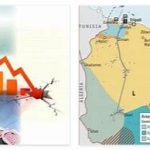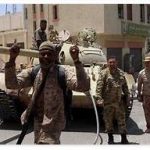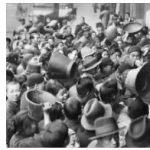State structure and political system of Libya
The role of the fundamental law is officially performed by the Koran, according to a brief Declaration on the establishment of the power of the people, adopted on March 2, 1977 at an extraordinary session of the highest legislative body – the General People’s Congress (GPC). This document proclaimed “direct democracy” – democracy exercised through basic people’s congresses, people’s committees, corporate and professional associations, as well as through the VNK. The Koran is declared the basic law – in fact, the equivalent of the missing “secular” constitution.
The principles of Libya’s unique system were formulated by M. Gaddafi to the middle. 1970s as the “third world theory” that denies capitalism and communism. The government, other state bodies, along with party and all other political institutions in the generally accepted sense, have been abolished since 1977 and formally replaced by a system of “direct democracy”. The Constitutional Declaration proclaimed its basis as local (primary) people’s assemblies of citizens. The entire adult population (from 18 years of age) of independent administrative-territorial units (quarters, villages) is obliged to participate in such meetings to directly address current economic, cultural, and other issues of a local scale; to discuss national problems of domestic and foreign policy, to make suggestions and recommendations, as well as for the election of permanent representative and executive bodies – people’s committees and their secretaries. Primary committees automatically form assemblies and elected bodies of the next, municipal level. Finally, the municipal committees in their entirety and the secretaries of the primary committees, together with representatives of the trade unions and other mass public organizations, form the supreme legislative body, the Supreme People’s Commissariat. More than half of its delegates are members of the secretariats of the primary and municipal congresses, formed mainly on a territorial basis. The remaining members of the VNC are delegated on professional and corporate grounds and are represented by members of the secretariats of the people’s congresses of corporate associations. At all industrial enterprises, construction and service sectors, primary people’s congresses (PNK) are created, consisting of all their employees who have reached the age of 18. These NPCs elect people’s committees from among the management, technical staff and workers, who carry out the functions of the state administration. The secretariats of the PNK of one profile form people’s congresses of the respective industries, where they represent the teams of their enterprises.
The WSC elects a general secretariat, which acts as the highest government body between sessions. The General Secretary of the GNC – Mubarak Abdullah al-Shameh (since March 2000) – is formally the head of state and legislative power. At sessions, usually annual, the WPC passes resolutions on national issues and appoints the Supreme People’s Committee (essentially the government) consisting of the committee’s general secretary (head of the cabinet) – Shukri Muhammad Ghanim (since June 2003) – and secretaries – the heads of the relevant secretariats (ministries).
The “leader of the Libyan revolution” – Muammar Abu Minyar al-Gaddafi – is formally only an honorary “ideological” leader of the country. However, without occupying any official positions in the Jamahiriya system, in fact, he concentrates all the fullness of real power.
The capital and seat of all foreign diplomatic missions remains the center of the most densely populated area – the city of Tripoli (over 1269.7 thousand inhabitants, est. 2003), although almost all government secretariats (ministries) have been moved outside it since 1988: most in the city of Tripoli. Surt, as well as in Benghazi (the second largest in terms of the number of inhabitants – 734.9 thousand), Kufra, Ras al-Anuf.
From the 2nd floor. 1980s Libya periodically conducts economic and political liberalization campaigns, many political prisoners have been released, and Libyan citizens are allowed free entry and exit from the country.
US sanctions against Libya, many of which have been in place since 1981, continued into 2003 despite widespread business dissatisfaction with them. On the contrary, the EU lifted most of the sanctions in September 1999 and invited Libya to participate in the Euro-Mediterranean partnership program adopted in Barcelona in 1995. Some European countries began to actively develop political and economic ties with Libya in the hope of making profitable investments there. However, the European arms embargo against Libya remains in place.
Armed forces (August 1999, thousand people): total – 65, incl. army – 35 (estimate), navy – 8, air force – 22. People’s militia – 40 thousand. Military appropriations for the 1999/2000 financial year 1.3 billion dollars, or 3.9% of GDP.
Libya has diplomatic relations with the Russian Federation (established with the USSR on September 4, 1955). At the end of December 1991 officially announced the recognition of Russia.
Science and culture of Libya
According to andyeducation, the Libyan education system, free at all levels, is fully funded by the state. School education 12 years, incl. 9 years (primary and secondary schools) compulsory. In the 1999/2000 school year, the schools of the first two levels had 766,087 pupils and 97,334 teachers. Another 717,000 students attended tertiary schools, vocational and teacher training colleges, and religious schools. At the same time, 287,172 students studied at 5 Libyan universities. The largest of them are Al-Fatih in Tripoli and Ghar Younis in Benghazi. In terms of the proportion of higher education students in the entire population, the country firmly holds the 3rd place in Africa (excluding many Libyans studying abroad).
Tripoli hosts the Libyan State Library and the National Archives, while the largest book depository (300,000 volumes) is the Ghar Younis University Library.
Since 1982, a scientific center for atomic research has been operating in the city of Tadjoura, the largest of the Arab ones, equipped with an experimental reactor and other sophisticated equipment from b. THE USSR.
The oldest known cities in the country are the Greek-Libyan colonies of Gurena (later Cyrene, now Shahhat) and Apollonia (Marsa-Susa) from the 7th century. BC. keep monuments of high ancient culture (serfs, residential, sports, memorial buildings, temples, theaters, baths). Probably their peers – Gara-ma (Germa, Djerma) and the predecessor of the current settlement of Jebel-Zinkekra – the first urban centers of the Garamants. The restored Roman amphitheater in Sabratha, founded by the Phoenicians, is the largest in Africa. No less interesting are museum expositions, epigraphic collections of libraries with ancient Egyptian, Libyan, Punic, Greek, Roman, medieval Arabic and Turkish manuscripts, as well as preserved arts and crafts and folk crafts: carpet weaving, embroidery, embossing on leather, etc.









